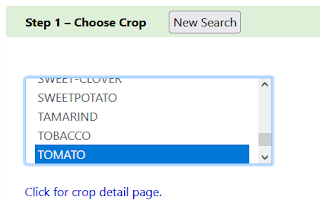The United States Agricultural Research Stations have a mission to conserve genetic material which is called germplasm in the trade.
Like nearly everything, much of the information is on the internet and it can be accessed through the germplasm resources information network. Searching for GRIN accession area query will generally find the front-door to the site.
I recently mined this site to see if there were any tomato varieties that would be exceptional for drying. This is how I used it.
Descriptors
The front page has a tab along the top labeled "Descriptors"
No, they couldn't use the word "Data". Apparently that would not be "fresh" enough for the young people.
Click on descriptors and you get this page.
 |
| I scrolled down the list and selected "Tomato" |
A list of traits that researchers collected data on pops up.
 |
| I selected BRIX (sugar content) and TA (total acidity) |
I thought that a tomato that started with a higher sugar and acidity content would be both more flavorful and have a higher "yield" of fresh tomatoes to dried product.
Part of my thinking was that drying times will be shorter if I start with higher BRIX .AND. I would have to handle/process fewer pounds of fresh fruit for each pound of dried product which should be a labor savings.
Scroll down to the bottom of the descriptor list to find the "verb"
 |
| Click on the "Select Values" button |
List wheels like this show up
 |
| The numbers are data...observed values. Choices in the boolean operator defaults to Equal to but I want "Greater than or equal to" |
 |
| I chose values that were slightly to the right of the center of the bell-shaped curve |
The database spit out 26 selections, most of which are small, close to wild varieties or are foreign cultivars that will be difficult to get seed for.
One really cool thing about this tool is that it also displays photos of the variety if they are available.
A few of the more interesting ones are:
 |
| Orange Jubilee. I have grown "Jubilee" tomatoes in the past and they are a nice plant and a nice tomato. 6.3% BRIX and 0.48% TA |
 |
| Wooly McArthur 6.2% BRIX and 0.43% TA |
 |
| Sponzillo. Not very large but it has a whopping 8.3% BRIX and 0.43% TA |
Observations
Many of the high-sugar, high-TA selections were from a Cheyenne, Wyoming Field Station. I assume there was a breeding program there and the breeder was selecting for these characteristics.
There are many, many different strains of "Jubilee" tomatoes. It is unlikely that all of them are high-sugar/ high-TA. Ironically, "Jubilee" tomatoes are often described as "low acid" but that might be because high-sugar can mask acid content. Our tastebuds sense the ratio between the two.
Another thing often listed in "Jubilee" type tomato descriptions is that it "stores well". That suggests that slices will not mold quickly on the drying rack on a cloudy day. Decay resistance may be related to tannin content and the acids keeping the pH lower than what most microbes desire.
Saving seed
If a fellow were serious about saving seeds and was interested in drying tomatoes, he might do well to invest in a refractometer to test fruit for BRIX. An optical refractometer needs about half an ounce of juice to measure and costs about $20 at this time.
Fruit from individual plants could be tested (picking three ripe fruit and squishing them for juice) and then only collecting fruit from the two with the highest BRIX.
Given the realities of photosynthesis, if you are selecting for yield and large fruit-size then you are also selecting away from sugar content because the plant can only photosynthesize so many carbs per day. Like most of the important things in life, it is a balancing act. There is a sweet-spot and it might be narrow or wide and it will likely vary depending on your garden and which resources are least abundant in your area.
Final note:
The ARS lists over 6000 tomatoes in their genebank and has only tested three-or-four hundred for BRIX and TA. That means that there are very big gaps in the information.
So use the results as a starting point. For instance, Wooly McArthur seeds are not commercially available but an internet search turns up many "Wooly" tomatoes. Some of the descriptions of those wooly tomatoes include terms like "intense taste" which suggests that they might be high in both sugar and acid.
Super interesting ERJ! Thanks for sharing!
ReplyDeleteGreat info Joe. Thanks much. ---ken
ReplyDeleteI had one like that for my saltwater aquarium. Only needed 3 drops of liquid to get a reading.
ReplyDeleteYou might be able to get some of the more unusual varieties of tomato from Sand Hill Preservation, they have many that are hard to find.
ReplyDeleteThat database could be really useful for a couple of gardening experiments that I want to try. Thanks!
Michele
Very interesting, and definitely a time sink, with possibly questionable results due to the paucity of actual measurements against the entire class of fruits... sigh
ReplyDeleteI made the mistake of doing something similar for potatoes. Now I'm down the rabbit hole of planting TPS (true potato seeds - tubers are basically clones of the mother plant i.e.. every potato of a particular strain is the produce of a single ancestral plant, an amazing realisation when you view the tons in every store. Whilst potatoes don't grow 'true' from seeds, they produce essentially new strains each generation. I'm generating some interesting, almost Andes like, crops.
ReplyDeleteThe Russians did a lot of work on 'breeding true' from seed and I have a few of their seeds I 'obtained' in a past life, too).
So please don't start me on tomatoes too (I have little enough time left for luxuries - like sleeping - as it is).